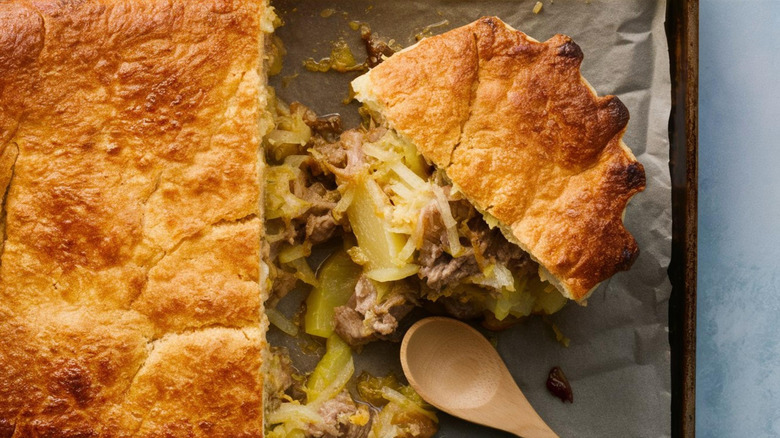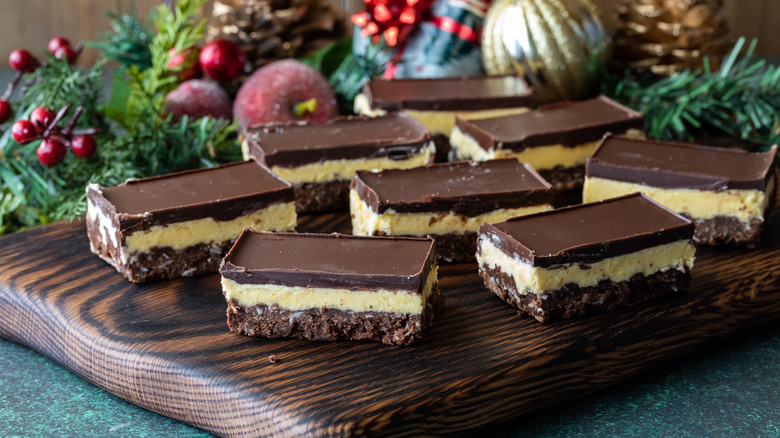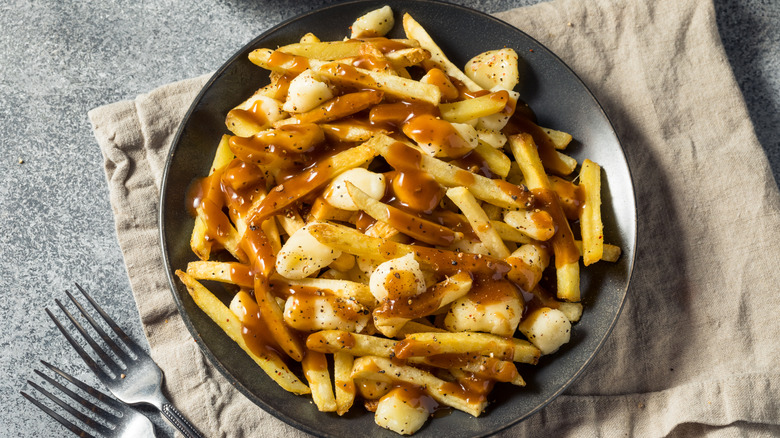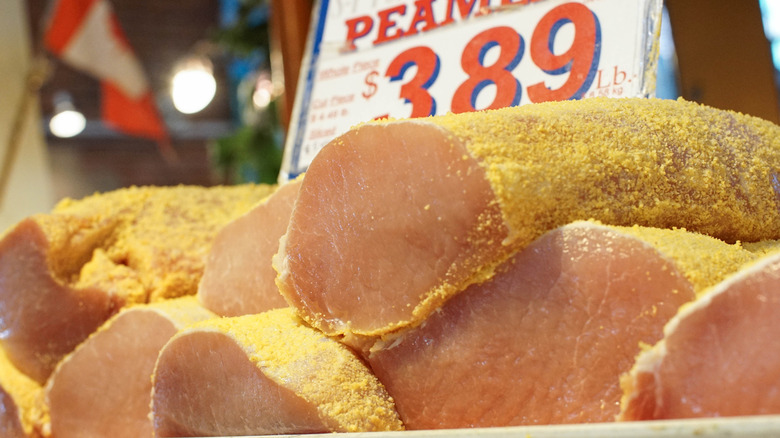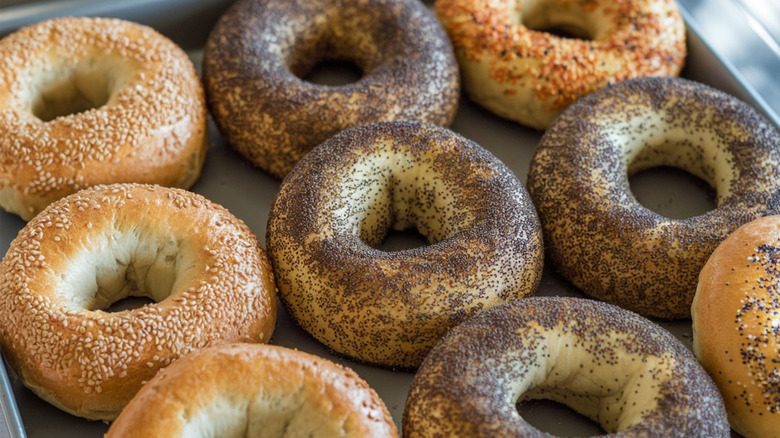15 Canadian Dishes You Should Try At Least Once
Canada may be known for its beautiful landscapes and friendly people, but its food deserves just as much attention. Sure, you'll find hamburgers, pizza, and steaks just like you would in plenty of other places. However, there are many unique Canadian dishes that you'd be hard pressed to find anywhere else. Many are rooted in tradition and showcase local ingredients, while others are modern creations that have been influenced by diverse cultures. Plus, there are a few foods you may be familiar with, but surprised to learn originated in Canada.
As a Canadian living abroad, I often find myself making a running list of foods that I miss and can't wait to eat whenever I visit home. The list includes nationwide favorites like poutine, Bloody Caesars, and butter tarts, as well as regional dishes like Halifax donairs and Montreal smoked meat. One of the great things about Canadian cuisine is that it's incredibly varied thanks to our multicultural population and expansive geography. That means that no matter where you go in the country, there's something different and delicious to try. If you're planning a trip to Canada or just curious about the food scene, these 15 Canadian dishes are a great place to start.
1. Rappie pie
Few people outside of Canada's Maritime provinces may know of rappie pie, but it's a classic East Coast comfort food and an important part of Acadian culture. The Acadians were French settlers who established colonies in Nova Scotia during the 1600s. They lived there until 1755 when the British expelled nearly 10,000 Acadians. Some went to Louisiana where they became Cajuns (a mispronunciation of Acadiens). Others went to Quebec, the Caribbean, or back to France. When some returned after 1764, they were forced to settle on farmland that was only really good for potatoes. And that's how rappie pie was born.
Rappie pie is a hearty casserole consisting of potatoes and meat. It may sound simple, but this dish is actually incredibly time-consuming to make. First, the potatoes must be grated and then squeezed to remove all the water. Then, they are layered in a casserole dish with shredded or diced meat (usually chicken) and covered with hot broth. The dish is then baked until it's golden brown outside and gooey inside. It can take all day to make, but the reward at the end is an ultra-homey and filling meal.
2. Nanaimo bars
Ask any Canadian what their favorite desserts are and Nanaimo bars will probably rank pretty high in the list. These decadent no-bake bars have three layers of goodness, including a graham wafer base with shredded coconut, a creamy custard center, and a chocolate ganache top. Some people play around with different flavors like adding peppermint extract or peanut butter. Purists will tell you that you can't beat the classic chocolate and custard combo.
Nanaimo bars are named after their place of origin in Nanaimo, British Columbia. The first printed recipe appeared in an auxiliary cookbook for the Nanaimo Hospital in 1952, although the dessert was simply called "chocolate slices." The following year, a recipe published in the Vancouver Sun gave the bars their name. Word about the chocolatey, creamy bars spread and they soon became a Canadian classic. Today, you can find Nanaimo bars across the country including in big-box stores like Costco and Walmart. You might see them called prayer bars and London fog bars elsewhere, but Nanaimoites know that their city holds the true claim to the name.
3. Bloody Caesar
Canada's most iconic cocktail is a must-have brunch beverage and hangover helper. Americans may find it familiar because it looks similar to a Bloody Mary. However, there are a few key ingredients that set the Bloody Caesar apart from its American counterpart. A classic Caesar consists of vodka, Worcestershire sauce, Tabasco sauce, and Clamato juice (a mix of clam juice and tomato juice). The cocktail is typically served in a glass rimmed with celery salt and garnished with a celery stick and lime wedge.
The Bloody Caesar was born in Calgary, Alberta, in 1969. That year, the owners of the Calgary Inn (now The Westin Calgary) asked bartender Walter Chell to create a signature drink in honor of their new Italian restaurant. Legend has it that Chell drew on his Italian roots and concocted the drink based on a dish he loved — spaghetti vongole. The drink was an instant hit and went on to become Canada's most popular cocktail. There's even a National Caesar Day, which falls on the Thursday before the Victoria Day long weekend in May.
4. Poutine
Poutine is by far Canada's most famous dish and it's pretty easy to see why. This French Canadian classic includes a trifecta of comfort foods: french fries, cheese curds, and gravy. The hot gravy melts the cheese curds so that each forkful gives you a beautiful pull of stringy cheese. Take a bite and you get saltiness from the fries, savory flavors from the gravy, and a mild fattiness from the cheese curds. It may not be the healthiest meal, but many will tell you that it's utterly addictive.
While the true origins of poutine are debated, the most likely story is that it was created in 1957 at Café Ideal in Warwick, Quebec, when a customer asked owner Fernand Lachance to add local cheese curds to his fries. Lachance reportedly told the customer it would make a mess, or "poutine" in Quebecois slang. Later, Lachance added gravy to prevent the fries and cheese curds from getting cold. You can find poutine in restaurants across Canada now, from chains like McDonald's to gastropubs and even some fine dining restaurants. You can also find creative versions with toppings like bacon, truffles, foie gras, and Montreal smoked meat.
5. Sushi pizza
If you've never had sushi pizza, it might sound like an absolute abomination. After all, who would want to fuse gooey cheese and molten tomato sauce with raw fish? That's not exactly what this strange-sounding dish is though. It actually features a base of fried sushi rice topped with thin slices of salmon sashimi, tobiko (aka flying fish roe), spicy mayo, and finely sliced green onions. It's all the rage in its birthplace of Toronto, Ontario, and has even spread to other cities across Canada and beyond.
The inventor of the sushi pizza was a French-trained Japanese chef named Kaoru Ohsada who worked at Nami Japanese Seafood Restaurant in Toronto in the early '90s. Ohsada told the Toronto Star that he was inspired to create something unique after eating a hash brown dish topped with smoked salmon. His sushi pizza was a huge success and went on to inspire many other copycat versions. Variations include sushi pizza with nori as a base along with the rice, different types of fish and sauce, and toppings like avocado and pickled ginger.
6. Montreal smoked meat
No visit to Montreal is complete without trying the city's most iconic dish: Montreal smoked meat. It's similar to New York-style pastrami, but has a flavor and texture that's all its own. While pastrami is typically made with the fatty navel cut of beef and wet rubbed with coriander and pepper, Montreal smoked meat is made with brisket that's dry rubbed with spices like coriander, mustard seed, and peppercorns. Both are marinated and smoked. Many find Montreal smoked meat softer, spicier, and smokier than pastrami.
There has been much debate over who created the first Montreal-style smoked meat, but evidence points to it being a kosher butcher by the name of Aaron Sanft, who came to Canada by way of Romania. Evidence shows that the A. Sanft Kosher Meat shop was advertising the meat as far back as 1894. While Sanft may have been the first to sell this style of smoked meat, many Jewish delis popped up in Montreal in the early 1900s and began selling their own versions. The traditional way to eat it is piled high on rye bread with a decent smear of mustard.
7. Butter tarts
Buttery, flaky, sticky, and sweet, butter tarts are a quintessential Canadian treat. There's nothing fancy about the tarts and that's exactly what people love about them. Traditional butter tarts consist of small pastry cups filled with a mixture of butter, brown sugar, corn syrup, egg, and vanilla. Some people also add raisins or swap out the corn syrup for maple syrup. The tarts are baked until the crust is golden and the filling has semi-solidified. Think of them like handheld pecan pies without the nuts.
The first printed recipe for butter tarts comes from Barrie, Ontario, where it appeared in a cookbook for The Women's Auxiliary of the Royal Victoria Hospital in 1900. Many believe that the rustic tarts were created out of basic ingredients that were available to people living in rural areas. Others believe that they may have been adaptations of similar tart-like desserts from France or Scotland. Either way, they're now ingrained in Canadian culinary heritage and a point of pride in Ontario. Visit the region of Kawarthas Northumberland and you can embark on the Butter Tart Tour, which features nearly 50 bakeries offering the sweet treats.
8. Tourtière
Traditional Christmas dishes in most parts of Canada typically include turkey or ham, roasted vegetables, mashed potatoes, and stuffing. However, if you happen to be in Quebec on Christmas Eve, you can sample a hearty dish that's steeped in French Canadian history: Tourtière is a meat pie that dates back to the 1600s. Catholic French settlers would commonly eat it after going to mass on Christmas Eve as part of a festive feast called réveillon. That tradition has carried through to the present day, although the ingredients of the pie have changed slightly.
A traditional tourtière consists of a flaky, buttery pie crust filled with savory meat and vegetables that are cooked in broth and seasoned with spices like cloves, cinnamon, nutmeg, and allspice. Centuries ago, the filling would have been game meat such as moose, rabbit, pheasant, or pigeon. While some people still fill their tourtières with game meat, ground pork and beef are much more common. You can also find tourtières filled with seafood like salmon, lobster, scallops, or trout.
9. Donair
Nova Scotia may be best known for its lobster, but it's also home to another dish that's just as beloved by locals. The donair is a delicious handheld meal that consists of a pita filled with thinly sliced beef that's been roasted on a spit like shawarma or al pastor taco meat. The meat is topped with diced onions and tomatoes and slathered in a sweet, tangy, and garlicky white donair sauce. It's the perfect late-night bite after bar hopping or just the right pick for when you want something ultra indulgent.
If donairs sound similar to Greek gyros or Turkish doners, that's because they were inspired by those dishes. In the early 1970s, Greek-born Peter Gamoulakos ran a pizza shop in Bedford, Nova Scotia, where he also sold gyros. Unfortunately, the gyros didn't hit with locals, so he decided to create a new version that catered to local tastes. He swapped the lamb for beef and concocted a sauce made with sweetened condensed milk, vinegar, and garlic powder. The donair became wildly popular and still endures today as a crave-worthy Atlantic Canada creation.
10. Peameal bacon
If you've had eggs Benedict before, then you've likely tried Canadian bacon (aka back bacon). Those round slices are made from pork loin that's cured and smoked. Canadian bacon has little to no fat but goes big on juiciness and flavor. What many people outside of Canada don't know though is there is another version of back bacon that some would argue is even tastier than the kind you often find in eggs Benny. It's called peameal bacon and it's a Toronto-born classic.
Legend has it that an English immigrant named William Davies was the first to create peameal bacon at his meat stall in Toronto's St. Lawrence market in the mid-19th century. He took brined pork loin and rolled it in peameal, presumably to help preserve the meat longer. The crunchy peameal coating gave the sliced bacon deliciously crispy edges when fried, making the meat perfect for breakfast dishes and sandwiches. Today, people often use cornmeal instead, which has the same effect. Fried peameal bacon tastes great on its own or sandwiched between bread with mustard.
11. Saskatoon berry pie
If you spend any time in the Canadian Prairies, there's a good chance you'll come across Saskatoon berry pie. This delectable dessert features Saskatoon berries, which are native to the region and can be found as far north as the Yukon and Northwest Territories and as far south as the northern United States, where they sometimes go by the name juneberries or serviceberries. The dark purple berries look like blueberries but have a unique sweet and nutty flavor that some liken to almonds. They work beautifully when mixed with sugar and a splash of lemon juice, encased in a buttery pie crust.
Indigenous people in Canada have a long history of using Saskatoon berries in everything from pies to bannock (flatbread) and tea. In fact, the city of Saskatoon is named after the Cree word for the fruit; Misâskwatômina means "fruit from the tree of many branches." Saskatoon berry pie has become a symbol of the Prairies and can be found at cafes, restaurants, and farmer's markets across Manitoba, Saskatchewan, and Alberta. You can also try Saskatoon berry jams, syrups, and wines.
12. Hawaiian pizza
Hawaiian pizza may just be the most controversial pizza style of all time. Some people love the sweet and salty combination of pineapple and ham, while others say pineapple on pizza is an absolute travesty. Adding to the discussion is the fact that it's not Hawaiian at all. The pizza was actually created thousands of miles away from Hawaii in the small town of Chatham, Ontario, making it a Canadian invention.
Sam Panopoulos was born in Greece but immigrated to Canada in 1954 and went on to open the Satellite Restaurant in Chatham. In 1962, he and his brother were experimenting with different pizza toppings and decided to try a mix of pineapple and ham. They named it Hawaiian pizza after the brand of pineapples they used. The brothers weren't sure how customers would react, but it turns out diners loved the sweet and savory combination. It didn't hurt that the tiki trend was exploding at the time and canned pineapples were all the rage. From that point on, the oddball pizza gained a cult-like following that it still enjoys today.
13. Montreal-style bagels
During the early 1900s, Montreal had an influx of Eastern European Jewish immigrants, and we have them to thank for many of the delicious foods you can find in the city today. For example, Montreal smoked meat went on to become one of the city's most iconic foods. Another beloved dish that became popular around the same time was Montreal-style bagels. Although there is some dispute about who first created this unique style of bagel, many point to either Hyman Seligman or Isadore Schlafman in the early 20th century.
There are several things that set Montreal bagels apart from other versions of these doughy baked goods. For one, they're traditionally made by hand with malt flour. Once the dough is formed into rings, the bagels are poached in honey water and baked in a wood-fired oven. The end result is a somewhat thin bagel with a golden crust, chewy interior, and a slightly sweet taste. They're great eaten as-is, but taste even better when toasted and topped with cream cheese and smoked salmon.
14. BeaverTails
For Canadian kids, there's no better winter treat than a BeaverTails pastry served piping hot with sweet toppings. The delicacy is made with whole-wheat pastry that's hand pulled into flat disc-like shapes that resemble beaver tails, hence the name. The dough is deep-fried in hot oil, then dusted with cinnamon sugar in the classic rendition. What you get is a tasty treat that's crispy on the outside and soft and chewy on the inside. You can opt for just cinnamon sugar or choose to top them with an array of enticing ingredients instead, like chocolate-hazelnut spread, marshmallows, bananas, and whipped cream.
BeaverTails are a relatively new addition to Canada's culinary scene. Pam and Grant Hooker started selling the tasty treats in Ottawa in 1978. The desserts are based on a recipe that Grant's German-Canadian grandmother used to make. She called them keekla (also spelled kuechle or kekle), but when the Hooker's daughter likened the pastries to beaver tails, the couple knew they had a catchy name. There are now close to 200 BeaverTails shops where you can get your fried dough fix.
15. Ginger beef
Many iconic Canadian dishes came about as a blending of different cuisines and cultures, and few exemplify this as well as ginger beef. This Chinese-Canadian dish was born at the Silver Inn in Calgary, Alberta, and went on to become a beloved classic. Opened in 1975, the restaurant served Beijing-style cuisine, but chef George Wong wanted to create something that would appeal to Albertan palates. He thought of french fries and beef, which inspired him to create a fried beef dish with a sweet and sour sauce influenced by ketchup.
Ginger beef typically consists of thin strips of beef that are battered in a cornstarch and flour slurry and deep-fried. The crispy beef is then tossed with veggies like onions and carrots and coated in a sticky sauce made with ginger, soy sauce, chiles, vinegar, and sugar. It's often served on rice, although you can sometimes get it with noodles. Sadly, the Silver Inn is no longer open, so you won't be able to try the original. However, many other restaurants have picked up the reins and are still carrying on the tradition.

